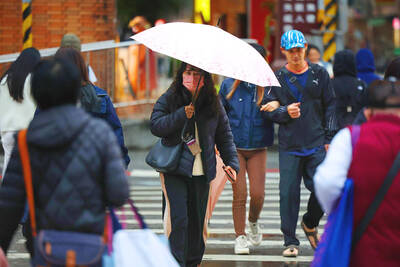A sculpture by Huang Tu-shui (黃土水) that was lost for more than half a century is to go on display this year, the Museum of National Taipei University of Education and the Ministry of Culture said on Thursday.
Huang, who lived from 1895 to 1930, in 1921 carved Sweet Dew (甘露水) from marble. It was the second work by Huang to be displayed at the Imperial Art Exhibition in Japan, the most prestigious art event in the country, where it received critical acclaim.
The sculpture was rediscovered earlier this year, 50 years after it was lost, by a team led by Lin Mun-lee (林曼麗), a professor at the university.

Photo courtesy of Huang Pang-chuan and Chunni Lin via CNA
Lin searched for the work for 20 years.
It was donated to the ministry last month, exactly a century after it was completed, and is to be included in an exhibition at the museum in Daan District (大安) opening in December.
The 1.75m sculpture was put on display in 1931, a year after Huang died of peritonitis, by the Taiwan Education Association at what is now the National 228 Memorial Museum in Taipei’s Zhongzheng District (中正).
However, the piece was abandoned at the Taichung Railway Station for unknown reasons after being transferred to the then-Provisional Taiwan Provincial Council in 1958.
The work was kept by a local family surnamed Chang (張) in their clinic until 1974, when it was moved to a factory in Taichung’s Wufeng District (霧峰), where it remained until being discovered by Lin.
Sweet Dew, which some call “Taiwan’s Venus,” is the earliest known nude statue in Taiwanese art history. It portrays a young woman with a calm yet confident countenance standing with her head tilted slightly backward and her hands holding a large shell behind her.
“It radiates an uplifting spirit, as well as being imbued with the artist’s imagination and anticipation for societal progress in Taiwan, marking a new chapter in Taiwanese art history,” the ministry wrote on Facebook.
“It is an explosive discovery,” Lin Chen-ching (林振莖), an assistant research fellow at the National Taiwan Museum of Fine Arts, was quoted by Chinese-language media as saying on Friday upon seeing photographs of the statue.
Although modeled after Sandro Botticelli’s painting The Birth of Venus, Sweet Dew reinterprets a goddess with the form of a Taiwanese female, ushering in a new art landscape for a new generation, as well as stunning the world with its beauty, he said.
Born at the beginning of Japan’s colonial rule over Taiwan, Huang was an iconic sculptor and the first Taiwanese artist to have works displayed at the Imperial Art Exhibition.
His representative works, which blended modern Western style with traditional Chinese elements, include The Chubby Playing Boy (山童吹笛), his first work to be shown at the Imperial Art Exhibition, and The Water Buffalo (水牛群像), which is on display at the Zhongshan Hall in Taipei.

NUMBERS IMBALANCE: More than 4 million Taiwanese have visited China this year, while only about half a million Chinese have visited here Beijing has yet to respond to Taiwan’s requests for negotiation over matters related to the recovery of cross-strait tourism, the Tourism Administration said yesterday. Taiwan’s tourism authority issued the statement after Chinese-language daily the China Times reported yesterday that the government’s policy of banning group tours to China does not stop Taiwanese from visiting the country. As of October, more than 4.2 million had traveled to China this year, exceeding last year. Beijing estimated the number of Taiwanese tourists in China could reach 4.5 million this year. By contrast, only 500,000 Chinese tourists are expected in Taiwan, the report said. The report

SHIPS, TRAINS AND AUTOMOBILES: The ministry has announced changes to varied transportation industries taking effect soon, with a number of effects for passengers Beginning next month, the post office is canceling signature upon delivery and written inquiry services for international registered small packets in accordance with the new policy of the Universal Postal Union, the Ministry of Transportation and Communications said yesterday. The new policy does not apply to packets that are to be delivered to China, the ministry said. Senders of international registered small packets would receive a NT$10 rebate on postage if the packets are sent from Jan. 1 to March 31, it added. The ministry said that three other policies are also scheduled to take effect next month. International cruise ship operators

Temperatures are forecast to drop steadily as a continental cold air mass moves across Taiwan, with some areas also likely to see heavy rainfall, the Central Weather Administration (CWA) said. From today through early tomorrow, a cold air mass would keep temperatures low across central and northern Taiwan, and the eastern half of Taiwan proper, with isolated brief showers forecast along Keelung’s north coast, Taipei and New Taipei City’s mountainous areas and eastern Taiwan, it said. Lows of 11°C to 15°C are forecast in central and northern Taiwan, Yilan County, and the outlying Kinmen and Lienchiang (Matsu) counties, and 14°C to 17°C

STEERING FAILURE: The first boat of its class is experiencing teething issues as it readies for acceptance by the navy, according to a recent story about rudder failure The Hai Kun (海鯤), the nation’s first locally built submarine, allegedly suffered a total failure of stern hydraulic systems during the second round of sea acceptance trials on June 26, and sailors were forced to manually operate the X-rudder to turn the submarine and return to port, news Web site Mirror Daily reported yesterday. The report said that tugboats following the Hai Kun assisted the submarine in avoiding collisions with other ships due to the X-rudder malfunctioning. At the time of the report, the submarine had completed its trials and was scheduled to begin diving and surfacing tests in shallow areas. The X-rudder,